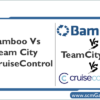
Anthillpro Comparison with Atlassian Bamboo – Continuous Integration Tools Review
ANTHILLPRO COMPARISON WITH ATLASSIAN BAMBOO AnthillPro Vs Bamboo OR Difference between AnthillPro and Bamboo OR Last month i was discussing with Eric Minick from Anthillpro on Why Build Engineer should…
Read more »
Perforce Quick Facts – Perforce Quick Start Guide
Perforce Quick Facts Clients ============================================== P4V: Visual Client – (Included in the P4V Installer) Provides access to versioned files through a graphical interface and also includes tools for merging and…
Read more »
Bamboo Vs TeamCity Vs CruiseControl – Continuous Integration Expert Review
Difference between Bamboo Vs TeamCity Vs CruiseControl TEAMCITY TC pre-tested commit is good. TC integrates to Visual Studio which is our main IDE. JetBrains are more focused on supporting .NET…
Read more »
File Comparing Tools Review and Feedback
File Comparing Tools review File comparison in computing is the automatic comparing of data between files on a file system. The result of comparisons are typically displayed to the user,…
Read more »
What are the minimum features for SCM tools? – SCM Tools Essential Features
SCM Tools
The minimum features for SCM tools are closely related to the task of handling the different product deliverables produced within the project software engineering process. Tool requirements and selection criteria are based on a series of features that provide a consistent look and feel with state-of-the-art software development environments. An SCM tool must have multiuser support, an intuitive graphical user interface, conformity to the organization’s development environment, scalability, flexibility in integrating other software development tools, ease of setup, modifiable models, process management, extensive support for the development phase, and management of nondevelopment objects.
Basic selection criteria includes the following:
Read more »

